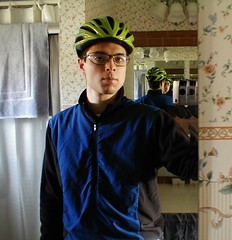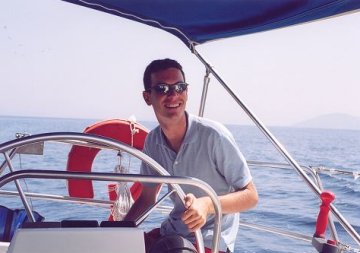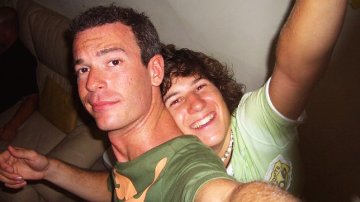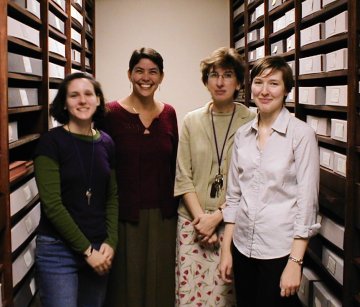• Contents
• Contact: jnm@rubberpaw.com
• Curriculum Vitae

• Recent Publications
• Recent Projects
• Conferences & Speaking
• (a)Musing (ad)Dictions:
Ideas. Tools. Art. Build --not buy. What works, what doesn't. Enjoy new media and software aesthetics at Tekka.
Theodore Gray (The Magic Black Box)
Faith, Life, Art, Academics. Sermons from my family away from home: Eden Chapel!
My other home: The Cambridge Union Society (in 2007, I designed our [Fresher's Guide])
The Economist daily news analysis
Global Higher Ed blog
• Hypertext/Writing
• Stats
Chapter I: Born. Lived. Died.
There is a Chapter II.
Locale: Lancaster County Pa, USA
Lineage: Guatemala
Religion: My faith is the primary focus of my life, influencing each part of me. I have been forgiven, cleansed, and empowered by Jesus Christ. Without him, I am a very thoughtful, competent idiot. With him, I am all I need to be, all I could ever hope for. I oppose institutional religious stagnation, but getting together with others is a good idea. God is real. Jesus Christ is his Son, and the Bible is true. Faith is not human effort. It's human choice. I try to be the most listening, understanding, and generous person I can.
Interests: Anything I can learn. Training and experience in new media, computer science, anglophone literature, education, parliamentary debate, democratic procedure, sculpture, and trumpet performance. Next: applied & computational linguistics, probably.
Education: Private school K-3. Home educated 4-12. Graduated Summa Cum Laude from Elizabethtown College in Jan 2006. As the 2006 Davies-Jackson Scholar, I studied English at St. John's College, Cambridge University from 2006 - 2008.
Memberships: Eden Baptist, Cambridge Union Society, ACM, AIP, GPA.
Alum of the Elizabethtown College Honors Program, sponsored by the Hershey Company.
|
January 2006
Vulgar?
Monday, 30 Jan 2006 :-: ["Permalink"]
[soundtrack]

When novelist Sarah Smith said in her email that her house was a "VULGAR YELLOW," I didn't know what to think. Now, after spending a delightful weekend with her family (Mariah, R2 and Gabriel Nobrega, and of course their dog Lady Jane), I know what she meant. Her home is unmistakable.
I was in the Boston area for eNarrative 6, held at Eastgate Systems. During the weekend, we spent two thoroughly-fun days discussing nonfiction and electronic media. One spinoff of the weekend was my discussion with Clare. More posts will follow, now that I have finally posted photos from the weekend.
Mark Bernstein connected me with Sarah Smith, true to his principles of "Writing the Living Web." This is the article which set me on the path to blogging (and largely influenced my academic/life MO). It was so much fun to spend a weekend with a group of people for whom creativity, imagination, and wordsmithing is intertwingled with life.
After a weekend with the Smiths, I could hardly call their home vulgar. So I wrote a poem:
Cosmic waste, or alien goo, or glue sticks from some primeval world with dandelion soup residue dripping, stewing, poured.
I can call these things Vulgar Yellow.
But hardly that enlightened house.
Golden? Sunny? Bold-chanced days
dim, fancy's whims unfold, set loose
contented sighs, and dance bouquets.
Unspectacular?
Saturday, 28 Jan 2006 :-: ["Permalink"]
While browsing Flickr, I recently found "The Unspectacular Doors of St. Louis" by Bill Keaggy.
Beautiful.
** * **
Writing is like this too, sometimes. Novels, short stories, and some of the best creative nonfiction is often about parts of experience and the universe which are entirely boring when encountered in real life. Such writing reminds us how special our world is. They remind us to keep observing, to keep laughing, and keep our sense of wonder, no matter how old we are.
** * **
 Do you believe in serendipity? The last two people from the St. Louis area I recently found on Flickr were both part of XPlane, a visual thinking company. The first was XPlane founder/CEO Dave Gray. Bill Keaggy was the second. Weird. But cool. (this is one of Dave Gray's paintings) Do you believe in serendipity? The last two people from the St. Louis area I recently found on Flickr were both part of XPlane, a visual thinking company. The first was XPlane founder/CEO Dave Gray. Bill Keaggy was the second. Weird. But cool. (this is one of Dave Gray's paintings)
(interview with Dave Gray on Supersized.org)
Dave Gray seems like an interesting guy. Artist, writer, consultant, educator. Here are some of his projects:
- Communication Nation, a blog about communicating, across various media and purposes, but not a news watch. I like his post on hypertext and electronic literature.
- Visual Thinking School on Squidoo, with accompanying flickr group.
- Visual Thinking Art, a group weblog he manages....."This site is dedicated to ideas, images, discussion and commentary related to visual thinking school and visual thinking projects. Please post your comments, thoughts and ideas."
- He also introduced me to some Moleskine Flickr groups.
- Scoble gave David Gray props after Evan Williams, former founder and CEO of Pyra Labs (which made Blogger) pointed it out to him. Speaking of which, Evan's latest project, Odeo, a web-based audio tool is very Web 2.0-ish.
Speaking of which, Scoble just recently linked to a very intersting health information search engine, which breaks your results into useful categories: Kosmix.
The web is an odd, interesting, interconnected place.
W00t.
Note: Bill Keaggy's photos of ordinary paraphenalia extend to the world of Grocery Lists. He is the founder of grocerylists.org.
** * **
When I was in St. Louis for the National Collegaite Honors Conference, I noticed that city was prime for urban renewal. I think it's starting to happen. Honestly, if *I* had the money, I would be starting a high tech business in St. Louis myself. Slow pace of life, nice climate, a great mass transit system, easy flights to the east/west coast, and great office space for a very low cost. St. Louis right now is a priceless opportunity for people with initiative. Dave Gray seems to be one of those people.
eNarrative Ideas
Wednesday, 25 Jan 2006 :-: ["Permalink"]
Last weekend, I spent a delightful time with the Eastgate crowd at eNarrative 6. More about that, including photos, later. But in the meantime, here's an after-the-conference conversation I had with Clare Hooper, the author of StorySpinner.
(the second half of this conversation was posted on Feb 14, 2006)
** * **
Mark Bernstein Asked: When authoring a hypertext, should one have a complete mental model of the work, or is it possible to make a good work too complex for even the author to fully understand, even in structure?
 Hmm, That's interesting. You could limit the question down to linear writing as well -- is it ok to start writing a novel, say, without a complete idea of where it's going? will it be inferior?.--
You could almost consider, say, a modern-day operating system: huge, sprawling, and no one coder is going to be able to fully understand it all. |
 If you're writing code, you have docs, and you know exactly how each part ought to work....
I think you have hit on something... when writing software, you only need to know about the immediate vicinity in order to make your code fit: you need to know the APIs used by your code and the parts of your code which the other software will use. |
 Ah, yes! This makes sense. |
 Hmm. This is how I authored my sculpture, come to think of it. To this day, I can't find individual items on my sphere |
 Heh! That does make sense though. Because with any complex creation - be it hypertext, a lengthy document, code - it's easy enough to forget intricacies after the act of creation, and, with increased complexity, perhaps during it too |
 When building the sphere, I focused on at the immediate, contextual view to fit things, and when I ran into a corner, I zoomed out, looked at the slightly-larger context, tweaked things, and zoomed in again. |
 Sounds like a great technique! |
 it's like refactoring code. |
 Again -yes, I was about to make that comparison :-). You need the low level and the high level view. |
 When you realize that the last 25 lines of your code really should be a function, you step back and make it a function. |
 Exactly! I think the act of creation, of whatever form of document or art-efact, is in some ways very similar across a vast sweep of genres and approaches -- The idea wouldn't have come about without this conversation :-) |
 I read a book, a year or so ago, about creativity, and the author urged her readers to apply the ideas within, whether they were dancers, painters, writers, whatever, and I think she's right.
The other thing that occurs is that people often see coding and the like as very uncreative - I have a technically brilliant friend who describes himself as utterly lacking in creative talent, but he's not right about that.
Creativity can take on many forms. |
 Right. Code is poetry. |
 Uhm, you seem to have got me going :-) |
 Go on... |
 I think this is all to do with the approach taken.
Any artist (using that term in the looser sense, someone who is creating something) needs to be able to juggle different levels of view - as you did with your sculpture, for example, or Mark's hypothetical hypertext author. |
 or even a painter |
 Absolutely!
The scale of the creation influences the amount of work required, of course, but I suspect that as long as the artist is able to juggle that view, to know what's going on *right here* in the work...
...then it should, with time and effort (and talent!), fall together.
I think! |
 and I suppose different styles work differently if you're writing a grand manner epic painting you might want to sketch it out first, think about the general colors and then go into the detail. By sketching it out you know you don't have to worry about the rest while you're working on detail because you already have a general idea. This is what I did, somewhat, with the sculpture. I already had a structure. |
 Yes, true. Whereas? |
 other sorts of art, you start with detail and work your way out, letting things interact as you go. This is what collage artists sometimes do, for example. Or some mixed media sculptors, or even artists who begin with studies in detail. |
 Yes, I think I see.
I wonder how much that approach relies on the art form taken, and how much on the personality of the artist? |
 Yes. :-) |
 :-) Some of the filling out of the overall idea is informal of course, thinking in the bathtub or what have you.
Hmmmm! |
 In the case of much creative nonfiction you have to start with detail, at least in the research phase ( which is intertwingled with the writing anyway).
You might have a plot, but you don't really have the story unless you figure out what pieces are available and begin to collect them.
Of course, this isn't always the case, but it is often the case in creative historical nonfiction. |
 Yes, you must work through the fabula, the basic plot elements, before you can construct something approaching a story or narrative.
Yes, I can see how that might be.
This is cool stuff ! :-) |
 :-) :-) |
After discussing that question, Clare and I also discussed the role of form and genre in answering the question of the impact of tools on how we create. I'll post that conversation tomorrow.
All Together
Wednesday, 25 Jan 2006 :-: ["Permalink"]
Why do we talk about our experiences?
Is it so our friends can catch up on our life? (does such storytelling mean we buy into the idea that we are irrevocably chained to the influence of our own histories?)
Is it so we can impress the people around us?
Do we tell stories to convince ourselves that our lives are exciting, are valuable, are worth it?
** * **
The process of devising a story of our life --or even of an episode of our life-- enables us to evaluate, consider, frame, and even judge our experiences. And yet, when we have written the story, the memories of experience crystallize into narratives which only partially restate the full truth.
To tell a story is often to close the seal on the mylar packages of our experiences before handing them out for consumption. Count the calories carefully.
Yesterday, my crazy friend Constantinos wrote me an email:
Well, we had an interesting road trip all together.
This is the stage I'm at when it comes to most of my experiences over the last six months. I have banks of photographs ready to go, but I'm not yet able/willing to tell the story of many of my most interesting experiences. My time in Salzburg, for example, or my Rhodes interview.
Sometimes, however, friends drag the details out of you. Constantinos writes:
We drove down there from Sydney in a mate's campervan.
I talked this way this last night with my parents when they wanted me to know about my recent trip to the Boston area for eNarrative 6. They were disappointed. They didn't really want to know what I did and what happened to me. They wanted interpretation. They wanted what Diane Greco talked about during the session on Sunday: Emotional truth.
They wanted a story.
** * **
Constantinos delivers a good story:
Him, myself and 3 girls in an overloaded/overseated vehicle of love with no insurance, no brakes (you could literally hear the brake pads rubbing up against the discs) and a king-size bed in the back that was doubling up as seating space for the extra people (curtains fully extended during drives onmotorway to prevent the police from spotting the extra cargo).
It was a miracle how we survived the drive, especially considering that we drove up and down an unsealed mountain road and camped in the middle of nowhere next to a river...
I thought I had seen it all in Australia but cat-sized white spiders were a first, I must admit...
There we were, enjoying the nature in the middle of nowhere, miles from the nearest anti-venom stockist when a gigantic eight-legged creation of nightmares gently climbed over my foot...
What followed upset several inhabitants of this otherwise wonderful nature reserve.
Needless to say, we slept with the tents and sleeping bags fully zipped up that night.
But that was not all... Another spider managed to sneak into my tent (of course!) and nested right above my head.
The wakeup was pretty instant. The others who were already up, said that they saw the walls of the tent expanding and bending and a torch being flashed around all over the place (I was attempting to squash it).
Australian nature? No thanks!
On a good note, we did have a lengthy one-to-one with the world's dullest Koala which we almost ran over.
We got off the car, stood there and watched it sit in the middle of the road and do absolutely nothing... For 20 minutes...
Perhaps they die sitting...
[....]several more paragraphs of story[....]
For now, it's back to work to try to get my last paper finished...
Do I really know what went on during his trip? Do I really want to know every detail? Not really, but it's nice to hear from friends, and it's even nicer to hear that interesting, enjoyable, and funny things are happening to them. Most of all, it's a reminder that (1) Constantine is in good spirits, and (2) he's still the crazy, weird, interesting, and fun guy I met in Salzburg last September (speaking of which, I should probably tell *that* story sometime), and (3) he's back to normal life, if anything can be considered normal for Constantinos Mantratzis.
Food and Philosophy
Wednesday, 18 Jan 2006 :-: ["Permalink"]
Thoughts are like calories. They don't come free. Keep eating without taking action, and you will quickly become unfit.
Coincidence?
Tuesday, 17 Jan 2006 :-: ["Permalink"]
I was recently asked if my comments on pharmacology were intentionally posted on the 100th Birthday of Albert Hofmann, the discoverer of LSD.
1 Pill, 490,000 Lives
Wednesday, 11 Jan 2006 :-: ["Permalink"]
Addendum: There's an interesting article in the June 2005 MIT Technology Review about Rotarix: The Vaccine That Almost Wasn't. According to the article, GSK is actually working pretty hard to deploy a rotavirus vaccine in the developing world. So I stand corrected. Here's what the MIT article says:
Still, Myers expects the Rotarix experience to be repeated at GSK: "We've made it clear that this strategy is not just a one-off." That could be good news for poor countries. The traditional model of developing a drug or vaccine and recouping costs in the developed world before introducing it farther afield leaves most of the world's population in peril. Myers expects other companies to follow GSK's lead in introducing vaccines and drugs quickly to neglected areas.
If GSK is really pioneering the deployment of new drugs to the developed world, why isn't there more about it in the news? Or has this been pretty big news? Did I miss it? In either case, it's pretty clear that GSK is doing a lot better than Merck/Rotateq.
Now for my original post:
** * **
As much as we value people who hop on airplanes to other places and spoon formula into the mouths of needy children, we should also cheer the people woh spend their lives in the lab. Pharmacologists really can make a difference.
A recent news release announced the successful testing of a vaccine for rotavirus, which kills 5 million children (mostly babies) each year. The vaccine has been effecetive in 98% of trials. They tested it on 68,000 infants.
** * **
Good news, eh? Hmm. It's hard to say. I was a bit confused by some of the language in the Science Daily articile, so I followed it to the original source. The Science Daily article was a perfect copy of a press release from the Eastern Virginia Medical School. Both of them noted that the RotaTeq vaccine was just a byline for an article in the New England Journal of Medicine about another vaccine, developed by GlaxoSmithKline. It also mentioned an editorial which "underscores the need for a rotavirus vaccine"
So I looked up the articles in the New England Journal of Medicine (a publication of the Massacchusetts Medical Society) I didn't even have to use my college's academic search. They're one of the sane journals and provide some free access to the fulltext of some new articles. So here they are:
The Promise of New Rotavirus Vaccines, by Roger I. Glass, Umesh D. Parashar.
Safety and Efficacy of a Pentavalent Human-Bovine (W3C) Reassortant Rotavirus Vaccine, by lots and lots of authors listed, probably mostly Timo Vesikari and David O Matson. Dr. Vesikari seems to have been pretty involved in Rotavirus research over the last decade at least. Dr. Matson is on staff at the Eastern Virginia Medical School, so there's clearly a connection. So far so good.
Dr. Vesikari's name brought me to a WebMD article, which is much more sensible than the Eastern Virginia Medical School press release. WebMD: New Rotavirus Vaccines Show Success. It looks like the study was a head-to-head betwen Merck's Rotateq and GlaxoSmithKline's Rotarix.
** * **
There's a lot of money to be made. In the U.S., around 80% of all infants get rotavirus, even though it's only fatal to a small number (deaths result from dehydration associated with the infection). According to a report by AVANT, a Phase II & III, clinical trails company, "The economic burden in the United States is estimated at over $1 billion from rotavirus desease in direct medical and indirect societal costs"
By 2004, AVANT had received over $2 million dollars to test this drug. Avant expects to receive about $5.5 million dollars to test Rotarix. Furthermore, they expect royalties on sales of Rotarix.
The AVANT is not entirely clear on their role in the trials. They only admit to Phase I, II testing of 215 subjects, not to being involved in the 65,000 patient trial done in Europe by GlaxoSmithKlein. Perhaps they had to be more careful and spend a lot more money for the initial trials. I don't know the drug industry too well. $25,000 per patient is probably cheap compared to other projects, when you think of all the time, product, and personell that goes into this.
** * **
AVANT didn't really expect to make much money on the early-phase clinical trials. They didn't even expect to make much money on royalties. Rather, they sold a portion of their royalties to Paul Capital Partners, a $4 billion dollar company who, among other things, purchases royalties from promising drugs. AVANT expects up to $61 million dolars from the Paul Royalty Fund II, L.P..
Remember, all this money going around is only related to a group that did an initial testing of 215 patients. (hmm. Other sources say that AVANT inlicensed the vaccine, which is a substantially bigger project that probably involved tweaking the vaccine for the large-scale testing that followed. Lots of lab work.)
** * **
This little investigation has shown me the power of press releases. They are often just pasted into the news sources, or if people are particularly savvy (like at WebMD), they are paraphrased into the news sources.
That's how we get figures that tell us that it could save half a million lives.
** * **
More information about rotavirus and the vaccines can be found on the Brown University Rotavirus page for BIO 160.
** * **
I think that it's OK if people have to throw around massive amounts of money to develop drugs and vaccines. It costs a lot to hire good researchers, techs, and marketing consultants. You have to find patients to test your new idea. You have to buy lab equipment and synthesize the materials. The medical industry is very costly. If we really want to help half a million babies, it's worth the expenditure, and the profits should go to the people who did the work.
But even though the people developing this vaccine talk about saving half a million lives, it won't reach the people who need it most. They might sleep at night knowing that they're making a difference, but are they really?
According to an article in Emerging Infectious Diseases (Global illness and deaths caused by rotavirus disease in children):
Children in the poorest countries account for 82% of rotavirus deaths. The tremendous incidence of rotavirus disease underscores the urgent need for interventions, such as vaccines, particularly to prevent childhood deaths in developing nations.
This brings us back to the original article about Rotateq, the first of the two vaccines I mentioned. The article states that after they get things going in the U.S. and other rich countries, Merck plans to look into its uses in developing nations. Heh. That's right. Target the biggest need last because it is the poorest area.
I'm sure they'll get around to it--someday, after they make a barrel of money in the developed world (some of the articles are horrible, with headlines suggesting that since Rotarix works in Mexico, it might work in Africa. It's a pill, for goodness sake! How callous can you be toward poor people?) But in the meantime, they have no compunction against citing the great global need and getting good press.
The Green Helmet
Tuesday, 10 Jan 2006 :-: ["Permalink"]

I haven't worn this helmet since my 16th birthday. I was celebrating by going on a several-hour ride to pick up a birthday present. Instead, I was hit by a car just two blocks from Elizabethtown College. I flipped through the air, banged my head on something, and landed on my knee.
The impact stove in the back of the helmet and shattered a lot of the styrofoam. God was looking out for me that day. My head was uninjured.
Even though I was 16, it took another six months before I was willing to drive a car. Post-traumatic stress disorder is very frightening.
I continued to train and tried to race some more. Bill Laudien, out of caution, held me back a bit. I was upset then, but now I'm thankful. In time, I chose a life of study over the thrill of cycling. I didn't just give up, however. I still love to ride.
In the end, the crash was a very positive part of my life.
For years, I kept the helmet as a reminder of the shortness of life and the thin shell which keeps us going.
The Bigotry of Poise
Thursday, 5 Jan 2006 :-: ["Permalink"]
Why is there an unspoken rule for delightful, marvelous things? For some reason, we seem to think that the height of cool is to treat beautiful things, places, and events with nonchalance.
This is worse than a lie. It is full disrespect for the marvels of life. There is beauty to be found in the small and grand parts of life: in the grey pebble that wanders in from the sea, in the sparkle of chandeliers, and in the precious tears of caring people.
Those who disrespect life attempt to show their personal quality by flaunting a sense of familiarity. This is lower than low. Surrounded by song, they cut off their own ears to show how great they are. Others, sated with marvels, gradually find their eyes dimming, even as they attempt to find the next, brighter gift.
** * **
Wake up! The morning clouds are lined with tufts of silver. The brown earth is deep and rich. See the foam upon the river, feel the cover of a book. Eat a strawberry. Savor the taste of something innocuous, like a bean. Discard the dulling context of the years. Consider the miracle of your very own body. Think about fingerprints and corneas and scabs and how we can do things, like eat ice cream and keep our balance and cuddle furry animals. Be a child. Marvel. Play.
** * **
Appreciate detail. You might even meet the Artist.
Company
Thursday, 5 Jan 2006 :-: ["Permalink"]
It's 9am, and the train to Philadelphia has just arrived at the 30th street Station. Steam hisses from the manholes as rainwater sears on hot equipment. Sunlight filters through, and birdflaps flutter between the iron rafters. A mosaic of wool overcoats, hats, and bags cacophonize strains of fashion clash, as designed individualism merges with purchased individualism to make...wait for it...Oh whatever, I'll drop the poetic, working-class boy schtick for one day at least.
I like taking the train to Philadelphia. Bags in hand, I rush down stairs, up stairs, into brown brick hallways. I set them down and wait. Signs scream silently. Rails clatter, and amplified voices call out, echoing in the subway cars. There is a rythm to the feet between the streets, on sidewalks and among the crowded spaces. In-between other, darker, one-way half-walks, we squeze between a building and the signs. Strides and cracks.I duck down a street, and within less than a block, there is peace. A workman eases orange cones out of his truck. In the sunlight, the damp roads gilsten.
There it is. I stop to adjust my things. To the side, Benjamin Franklin looks on: austere, but friendly. I'm here.
I'm in good company.
** * **
Call me odd, but of all the places I have visited during my research in Philadelphia, I have most thoroughly enjoyed time spent at the Library Company of Philadelphia. It's not just a building, not just an institution founded by Benjamin Franklin, not ust a repository of information and artifact. It is one of those legendary places in a city you think can only be imagined, the sort of place you only expect to find after wandering, aimlessly lost, only to stumble into some unknown doorway, into a new world. Imagine, then my surprise and delight to find this place a second time, and to find it just as marvelous.
There are smiles here.
The information, artifacts, and archives are pretty good too ;-). The Library Company provided nearly a third of the source images for the Philadelphia Fullerine, a sculpture project I completed last year. They do marvelous, efficient, professional work. When I visited, the people of the Library Company prints department scurried about trying to find things which could work. It was like a feast. The ladies just kept on sliding boxes in front of me.
Charlene Peacock, on the right, has been particularly helpful to me, but I must admit. Everyone has been so helpful and cheerful. During my visits to the Library Company, I truly felt like I was in good company.
** * **
I recently received an email from the Library Company. My sculpture/hypermedia on Philadelphia History has been featured in the LCP Newsletter!
Clink. Clank. Think.
Wednesday, 4 Jan 2006 :-: ["Permalink"]
Time Magazine, 1955:
The prospects for mankind are truly dazzling. Automation of industry will mean new reaches of leisure, new wealth, new dignity for the laboring man.
sigh.
I had a conversation last week with a very intelligent man I respect highly. He suggested that the 'net is creating a neural network of people who will reach new heights of thought via the interactions of millions of people online. He may be right.
I myself often think utopially (tapioca-lly?) when I think about the 'net. But, it seems, the greater tools we have for power, the more our collective faults are thrown into stark relief.
|




 If you're writing code, you have docs, and you know exactly how each part ought to work....
If you're writing code, you have docs, and you know exactly how each part ought to work....



